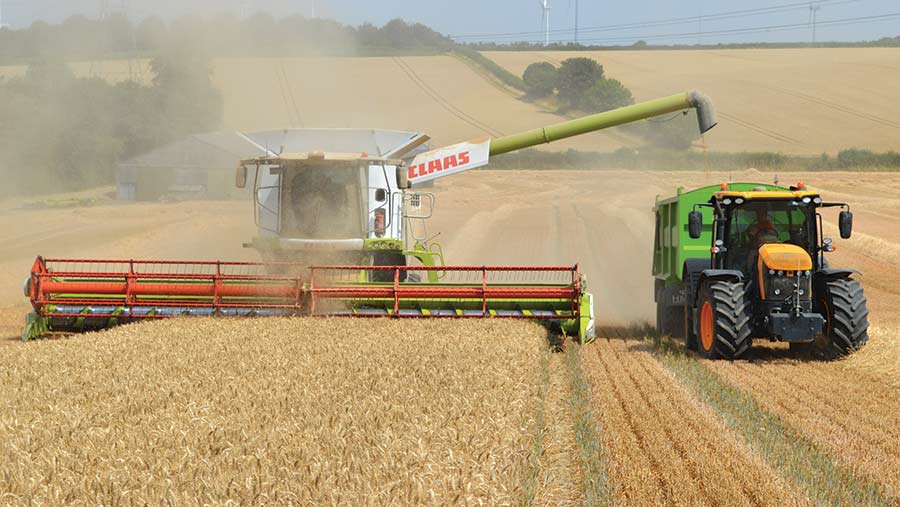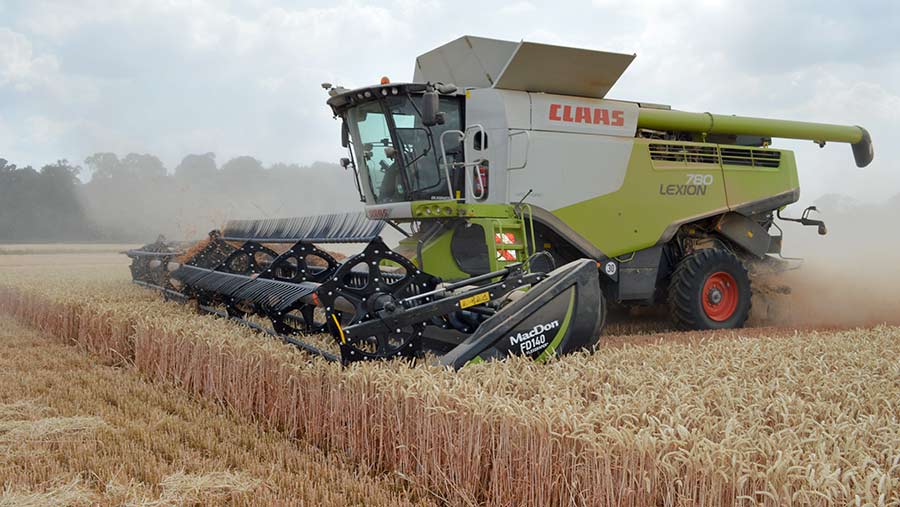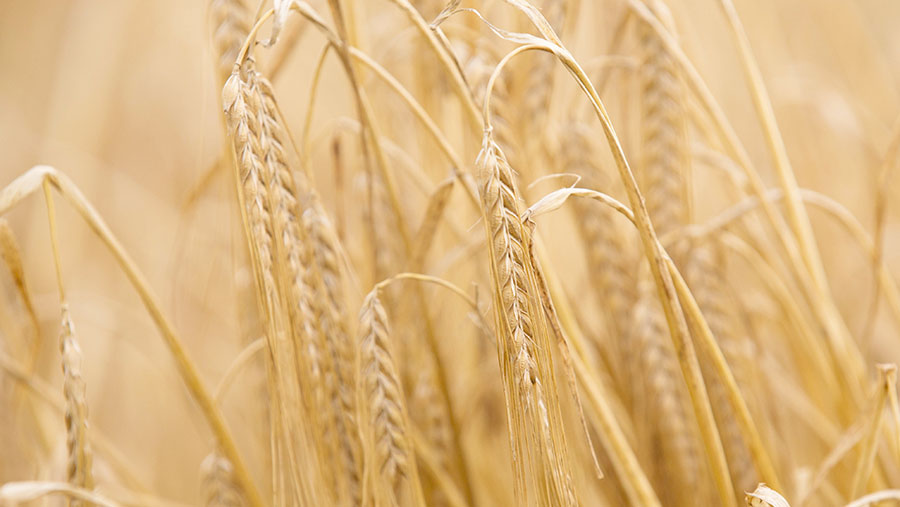Harvest 2018 video: wheat quality good but yields disappoint

The early wheat harvest is producing generally high-quality grain although yields are lower, with many crops having seen no rain for more than two months in the summer heatwave.
Early milling wheat crops are showing good protein, Hagberg and specific weight values which is already putting pressure on the milling price premium, while millers are working out how to process such dry and brittle grain.
Many wheat crops are seeing yields typically down 15-20% across southeastern England, the area worst hit by soaring temperatures.
Andrew Tetlow started cutting wheat two to three weeks early in Cambridgeshire last weekend and fared better than most, with his first field of Skyfall milling wheat yielding an impressive 9.8t/ha, close to the 10t/ha he normally expects from first wheats.
See also: Why two growers have warmed to German high-protein wheats
Watch the video of Andrew Tetlow in Cambridgeshire and Jeremy Durrant in Essex cutting wheat and read the full report below.
Earliest harvest for more than 40 years
“This is the earliest harvest we have seen since the drought of 1976, as we saw nothing but cold and wet until mid-May and then a heatwave,” he told Farmers Weekly.
Quality was good, with Hagbergs above 360 and specific weight at 80-83kg/hl, but grain protein was a little low at 12.3% as there was no rain to wash nitrogen fertiliser into the soils.
Breadmakers tend to look for milling wheats which meet a standard of at least 13% protein, 250 Hagberg and 76kg/hl specific weight.
He says grain yields are being very soil specific, with this crop grown on a loam over chalk, with the chalk acting as a sponge for moisture to keep the crop growing and the grain filling even in the sweltering temperatures.
Mr Tetlow is a partner of AWT Farm Services, farming about 2,000 arable hectare for a number of landowners in Cambridgeshire, Essex and Suffolk, and he expects that harvest could be over by the first week of August if this dry weather continues.
The group is growing 925ha of wheat including Skyfall, along with feed wheats Costello and Diego. The first crop cut was near Balsham, 10 miles southeast of Cambridge, on Saturday 21 July.
Winter barley yielded well for the year on the farm, with 27ha of Bazooka cut at 8.8t/ha and 502ha of oilseed rape – largely Campus and some Extrovert – reflecting the poor season at just 3.3t/ha.
Essex wheat
Results were more disappointing for Essex farm manager Jeremy Durrant, with his first block of 50ha of Siskin yielding just 8.2t/ha when he was expecting 11t/ha on his classic good heavy wheat land.
The variety showed good quality at a specific weight of 76kg/hl, Hagberg in the low 300s and a protein of 12.5%, but when he started cutting the wheat on 19 July the yield was simply not there.
He has moved into a block of Kerrin feed wheat which is yielding just shy of 9t/ha when he was expecting 12t/ha, with the grain failing to fill well in the dry weather.
“We are seeing poor yields due to drought, with no rain since mid-May and damage from blossom midge,” he said.
Midge damage
Mr Durrant is seeing damage from orange and also lemon wheat blossom midge, which is also being reported in farms in Suffolk. Grain experts said the midges were not a storage pest as they tended to die in store and then could be cleaned using an air blower in store.

Mr Durrant grows more than 600ha of wheat on 1,300ha of land at EW Davies Farms based at The Hydes, Thaxted. Varieties include Kerrin, Santiago, Kielder and Gravity along with milling wheats Siskin, Crusoe and Zyatt.
Winter barley was his best crop with 13ha of Bazooka yielding 9t/ha, while just over 50ha of the oilseed rape variety Fencer yielded 3.4t/ha, when he was hoping for 4t/ha.
Both growers are members of Camgrain and Philip Darke, operations director at the grain co-operative, said wheats he has seen were showing variable protein levels while Hagbergs were very good.
“Generally the quality is good while yields are down, but not by as much as first feared,” he said.

© Tim Scrivener
For up-to-date trial data covering early yields of winter barley read more on the 5 top yielding winter barleys
Miller’s view
Grain users are also reporting good quality, with miller ADM saying early wheat samples look generally good for protein, Hagberg and specific weight, although the grain is very dry and brittle.
“We are looking to assess the quality quickly and set our mills to deal with the low moisture and hardness of the grain,” said Mark Ringrose, trading manager at ADM.
The miller, which buys more than 800,000 tonnes of wheat annually, is seeing grain moistures as low as 11%, drier than it sees from North American wheats.
Mr Ringrose added that yields looked to be down 15-20%, while specific weight was generally good, as often the bottom third of the wheat ear had aborted, leaving the top two-thirds to fill reasonably well.
Yields under pressure
Essex grower Tom Bradshaw agreed, saying his winter wheat yields were down 15-20% after he had cut his best fields with yields about 8.5t/ha, compared with his average yield of 10t/ha.
“Yields are very variable, largely soil related, but specific weights are fine,” he said.
He is growing 520ha of Group 2 milling wheat, such as Siskin and Lily, at Fletchers Farm, Fordham, near Colchester, and he expects his 480ha of spring barley and oats, soon to be cut, to be disappointing, along with many other struggling spring crops this season.
Grain quality promising
Zoe Andrew, key account manager for grain trading at Frontier, reports wheat yields of between 6t/ha and 10.5t/ha, with quality really good in terms of protein content and Hagberg, while specific weight is suffering only on the light land.
“Quality looks really promising, and with the potential for a big milling crop we are starting to see the milling premium narrow,” she added.
However, these are early days for the wheat harvest, with only a small fraction cut and with most of the feed wheat crop in the north of England and Scotland still to combine.
